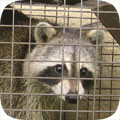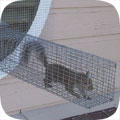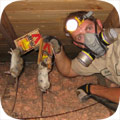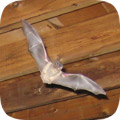- ridgefield@wildlifeanimalcontrol.com
Call 24/7 for a free quote:
203-702-1688
Ridgefield Wildlife Animal Control
Professional Wildlife Removal Company Servicing Ridgefield, CT
If you have a problem with wildlife in your Ridgefield home, your best option is to hire a company that specializes in Connecticut wildlife removal only. This is a specialty business, and regular pest control companies do not use the proper techniques to solve animal problems. I have spent many years reviewing Connecticut and Ridgefield, and I recommend the following:
Bats R Us Wildlife
Cell Phone: 203-702-1688
NOTE: If you have a dog or cat problem, call Fairfield County Animal Services: 203-576-7727

Bats R Us Wildlife specializes primarily in removing animals from attics of homes and buildings - this includes squirrels in attics, raccoons, and rats or mice in homes. Connecticut also has a documented problem with
bats in buildings, and Bats R Us Wildlife is specially trained in bat removal. They also perform general wildlife trapping services, such as the capture and removal of skunks or opossums on the
property. Call 203-702-1688 to discuss your critter problem and schedule a same-day or next-day appointment. Click here to learn more about
what prices we charge in 2025.
When hiring a company to solve your wild animal problem, you want these features:
- Specializes in wildlife removal, not pest control
- Fully Connecticut and Fairfield County licensed and insured
- Works 7 days per week (critters don't take weekends off)
- Performs full building inspections: enters and inspects attic
- Performs exclusion repairs, with guarantee against animal re-entry
- Offers cleanup of biohazardous wildlife waste
Bats R Us Wildlife is a full-service Ridgefield wildlife removal company. This is very different from a regular Ridgefield pest control company. The pest control companies spray poison to kill insects. This is not at all
similar to wildlife removal. Bats R Us Wildlife performs a full inspection of the home or property, and determines why the animal(s) are there, and if inside a building, how the animals got inside. All
animals (including rodents) are trapped and removed, or if possible, removed from the building using special exclusion devices. Once the animals are gone, preventative repairs are essential, and
cleanup is sometimes recommended.
 Ridgefield wildlife trapping - it's not as simple as it may seem. It's illegal in Connecticut to trap without a license. Trap type is very important and there are many different types, bait is somewhat relevant, trap placement
is vital, and there are dozens of small things that are very important to know.
Safety is a concern. Then once the animal is trapped, it must be removed and dealt with in the proper manner according to Connecticut law. We offer Ridgefield raccoon removal. Read more about how to get rid of raccoons.
Ridgefield wildlife trapping - it's not as simple as it may seem. It's illegal in Connecticut to trap without a license. Trap type is very important and there are many different types, bait is somewhat relevant, trap placement
is vital, and there are dozens of small things that are very important to know.
Safety is a concern. Then once the animal is trapped, it must be removed and dealt with in the proper manner according to Connecticut law. We offer Ridgefield raccoon removal. Read more about how to get rid of raccoons.
 Animals in attics - this is our specialty at Bats R Us Wildlife. Many types of animals like to live in attics. This includes squirrels, raccoons, rats, mice, bats, birds, and even possums. Critters like to go into attics for a safe place to live
and raise their young. Removing animals from attics is very complex work, partly because of the presence of baby animals. If you need Ridgefield squirrel removal, we can remove all the squirrels from your attic, and seal out any future ones. Read more about how to get rid of squirrels.
Animals in attics - this is our specialty at Bats R Us Wildlife. Many types of animals like to live in attics. This includes squirrels, raccoons, rats, mice, bats, birds, and even possums. Critters like to go into attics for a safe place to live
and raise their young. Removing animals from attics is very complex work, partly because of the presence of baby animals. If you need Ridgefield squirrel removal, we can remove all the squirrels from your attic, and seal out any future ones. Read more about how to get rid of squirrels.
 Rodent control must be done in a very specific way. First off, the most important thing is that all the openings that rats and mice can use to enter a house be sealed. Then all the rodents must be physically trapped and removed.
Never, ever use poison! Most Ridgefield exterminators will just use this lazy poison technique to kill rodents, and it causes more harm than good - dead stinky rats, and it doesn't solve the problem. Call us for correct Ridgefield rat removal. Read more about how to get rid of rats.
Rodent control must be done in a very specific way. First off, the most important thing is that all the openings that rats and mice can use to enter a house be sealed. Then all the rodents must be physically trapped and removed.
Never, ever use poison! Most Ridgefield exterminators will just use this lazy poison technique to kill rodents, and it causes more harm than good - dead stinky rats, and it doesn't solve the problem. Call us for correct Ridgefield rat removal. Read more about how to get rid of rats.
 Bat removal is a highly specialized task. Connecticut is known to have colonizing bats who often live in buildings. Bats love attics. If not removed, the colony can grow to a very large size over the years. The bat droppings are often corrosive and
cause health risks. The same goes for bird droppings on or in buildings. We perform Ridgefield pigeon removal and bird control. But our specialty is Ridgefield bat removal. We remove 100% of the bat colony and seal the building so that it's totally bat-proof. Read more about how to get rid of bats.
Bat removal is a highly specialized task. Connecticut is known to have colonizing bats who often live in buildings. Bats love attics. If not removed, the colony can grow to a very large size over the years. The bat droppings are often corrosive and
cause health risks. The same goes for bird droppings on or in buildings. We perform Ridgefield pigeon removal and bird control. But our specialty is Ridgefield bat removal. We remove 100% of the bat colony and seal the building so that it's totally bat-proof. Read more about how to get rid of bats.
 If you have animals inside a house, no job is complete without proper exclusion repairs. If you simply hire a Ridgefield trapper who only removes the critters, then the problem will return. You need to hire a Ridgefield wildlife control company that identifies 100% of the animal entry points
into your building, and seals them shut with professional repairs. In addition, in many cases animals have left waste or contamination behind, and you'll want a company that can provide professional cleaning services. Bats R Us Wildlife does both.
If you have animals inside a house, no job is complete without proper exclusion repairs. If you simply hire a Ridgefield trapper who only removes the critters, then the problem will return. You need to hire a Ridgefield wildlife control company that identifies 100% of the animal entry points
into your building, and seals them shut with professional repairs. In addition, in many cases animals have left waste or contamination behind, and you'll want a company that can provide professional cleaning services. Bats R Us Wildlife does both.
The above are just some of the services offered by Bats R Us Wildlife. We also trap and remove animals that destroy lawns, such as moles, or digging animals. Sometimes animals like opossums will live under buildings, steal pet food, raid garbage cans, etc.
Read about how to get rid of opossums. Skunks commonly live under sheds or decks, and set up a den. We can trap and remove them without them spraying. Read about how to get rid of skunks. Bats R Us Wildlife
also provides dead animal removal in Ridgefield. If you need help with any other wildlife conflict, from a fox, beaver, groundhog, or any other critter, we can solve it. We also do Ridgefield snake removal - most of the snakes in Connecticut are not venomous, but
call us if you want safe removal, or read about how to get rid of snakes in Ridgefield. And remember, we are a private business, not Fairfield County Animal Control Services, so if you have a dog or cat problem, call the County at 203-576-7727.
Fairfield County animal services does not handle any wildlife issues.
Bats R Us Wildlife
Cell Phone: 203-702-1688
Ridgefield Pricing Info
Every wildlife removal situation is different, from the species of animals involved, the location of the animal inside a house or outside, the extent of repairs or cleanup, etc. It's impossible to give one-size-fits-all prices. Examples MIGHT include:Small Job: For example, a one-stop job to remove an animal in the yard: $100 on up
Medium Job: For example, getting critters out of your house with minor repairs: $300 on up
Large Job: For example, a project involving many service trips and complex work: $500 on up
Give us a phone call now and tell us about your wildlife issue and we will be able to give you a price estimate over the phone. If you're cool with it, we can schedule a same-day or next-day appointment if you like. Our prices are fair, and a good value because we do the job right, the first time.
Ridgefield Wildlife Tip #1:
What time does nocturnal wild animal go out to get food? - In order to effectively remove the nocturnal wild animal problem from your house, let's say for example, it's currently claiming squatter's rights in your attic, you must have some useful bits of information. These animals are smart - they have been around since the age of the dinosaurs after all! One of the most useful things that you can learn about the nocturnal wild animal is the time at which they go out to feed - this will essentially better help you to set traps, figure out when to block entrances and exits, and generally start on your plan to remove the annoying creature from your attic. Take a look at the sounds that you hear noise from the nocturnal wild animal - it's usually when you are in bed. This gives you some idea of when they are most active. They are nocturnal creatures by nature, although they are venturing out in daylight hours more and more these days, especially as they seem to becoming rather used to people and rural living. However, you will often find that your friendly nocturnal wild animal will wake up at around 9pm, potter out to work, (as in search for food) at around 9/10pm, and then head home for a good night's sleep at around 4am. This gives you plenty of time to block exits, work out where they are getting in and out from and set traps in the right areas. Your main priority at this time may be evicting the nocturnal wild animal completely from your property, but in actual fact by doing this, you are just encouraging other nocturnal wild animals and wild animals to come running. Rather than looking at getting rid of the animal completely, why not consider placing a nest box at the end of your yard? This gives the animal somewhere that it is "allowed" to live, and it will help remove the problem from your attic at least!
Ridgefield Wildlife Tip #2:
Will a skunk in a trap always spray - If you set up the trap as professional recommend, the likelihood of a skunk spraying is lessened. Because a cage trap suddenly snaps shut, there is always a chance a young, scared skunk will let its glands loose. Older skunks have better control, but if the animal is too scared or stressed, it might spray. The best way to avoid this scenario is to cover your cage trap with a tarp or a heavy blanket. If the animal doesn't accidentally spray when the trap snaps shut, the blanket will keep it calm because it eliminates visual stimuli. A skunk won't spray unless a target is clearly seen. There are also special traps you can purchase online made just for trapping skunks. These have solid sides and work in the same manner as a trap covered with a tarp. If you're lethally trapping skunks, there is a good chance they will spray after death. Just like a human body loses control of bladder and bowels in death, the muscles in the skunk will relax, making a release of the odorous spray more likely.
Connecticut Wildlife Information:
Connecticut State bird: American robin
State mammal: Sperm whale
State fish: American shad
State insect: European mantis
Connecticut is a small state in the nation, and despite being technically on the coast of the country, it does not have an ocean border. The state is connected to the Atlantic Ocean through Long Island Sound and Block Island Sound, but has no actual sea coast of its own. The majority of the state was originally wooded, though areas of farmland have since been cleared. The forests are full of broad-leaved trees with a mixture of coniferous woodland, and there is a steady rise of terrain to the mountains in the northwest. Summers in the state are warm to hot, and winters are cold; the ocean mediates temperatures and moisture content in the atmosphere.
The state does not have a huge variety of large animals. The moose is the dominate creature on land in size, and it is the only large grazer aside from white-tailed deer. A subspecies of the white-tailed deer, called the key deer, grow to be only 3 feet tall and weigh up to 80 pounds. This subspecies is protected due to dwindling numbers. The key deer are easy targets for coyotes who roam the forested regions of the state. Black bears are also present, but the bears rarely take to hunting down large prey. Black bears spend much of their time foraging for fruits and insects, or raiding easy meal locations like birds' nests. The state has a healthy population of bobcats that keep the numbers of smaller animals manageable.
As in most states of the Northeast, Connecticut has a variety of forest-dwelling critters that hold the potential to become pest animals. Raccoons, skunks, opossums, rats, mice, bats, gophers, woodchucks, weasels, minks, and beavers are all occupants of the state. Connecticut has lemmings, small, elusive rodents that have gotten a reputation for mass suicides. These communal death marches are a misnomer; the lemming will sometimes migrate in numbers during the breeding season. Because the animals are good swimmers, they will often attempt to cross waters where a significant number of them drown. They are not throwing themselves off cliffs for no apparent reason.
Though access to the ocean is had by way of a protected region of water, Connecticut has a number of marine animals including manatees and harbor seals.
You can always call Bats R Us Wildlife, any time of day, at 203-702-1688, for a price quote for Ridgefield wildlife control services. I am confident that this is the best choice amongst wildlife removal companies in Ridgefield, CT.







































